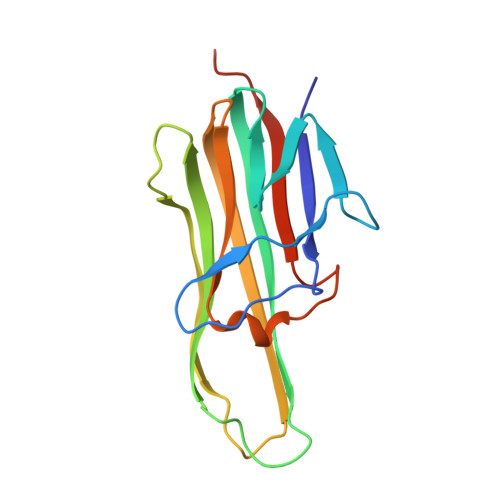Crystal Structure of Human RANKL Complexed with Its Decoy Receptor Osteoprotegerin
Luan, X.D., Lu, Q.Y., Jiang, Y.N., Zhang, S.Y., Wang, Q., Yuan, H.H., Zhao, W.M., Wang, J.W., Wang, X.Q.(2012) J Immunol 189: 245-252
- PubMed: 22664871
- DOI: https://doi.org/10.4049/jimmunol.1103387
- Primary Citation of Related Structures:
3URF - PubMed Abstract:
Receptor activator of NF-κB ligand (RANKL), its signaling receptor RANK, and its decoy receptor osteoprotegerin (OPG) constitute a molecular triad that is critical in regulating bone remodeling, and also plays multiple roles in the immune system. OPG binds RANKL directly to block its interaction with RANK. In this article, we report the 2.7-Å crystal structure of human RANKL trimer in complex with the N-terminal fragment of human OPG containing four cysteine-rich TNFR homologous domains (OPG-CRD). The structure shows that RANKL trimer uses three equivalent grooves between two neighboring monomers to interact with three OPG-CRD monomers symmetrically. A loop from the CRD3 domain of OPG-CRD inserts into the shallow groove of RANKL, providing the major binding determinant that is further confirmed by affinity measurement and osteoclast differentiation assay. These results, together with a previously reported mouse RANKL/RANK complex structure, reveal that OPG exerts its decoy receptor function by directly blocking the accessibilities of important interacting residues of RANKL for RANK recognition. Structural comparison with TRAIL/death receptor 5 complex also reveals structural basis for the cross-reactivity of OPG to TRAIL.
- Center for Structural Biology, School of Life Sciences, Ministry of Education Key Laboratory of Protein Science, Tsinghua University, Beijing 100084, People's Republic of China.
Organizational Affiliation:


















